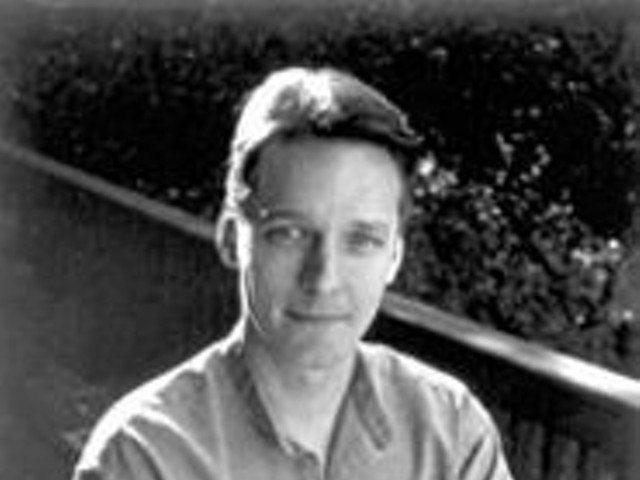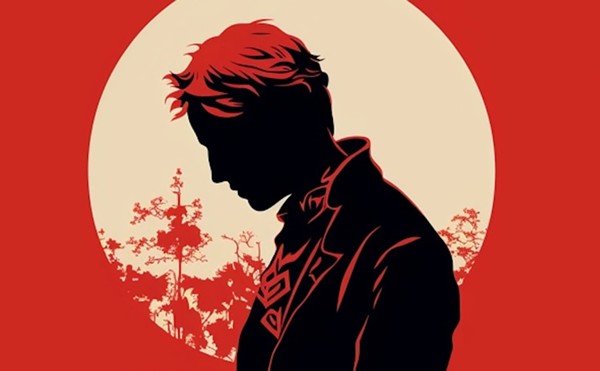In addition to the reflecting pool installation, Tadao Ando/Architect features photographs, sketches and models of 17 of Ando's built and soon-to-be-built structures around the world. Most of the show is fairly standard as architectural exhibitions go, but one nevertheless comes away with a strong sense of Ando's creativity and versatility. Throughout his career, Ando has produced everything from tiny row houses to large museums. And his metier is not limited to the poured concrete for which he is well known; as this exhibition shows, he has produced incredibly nuanced works in wood and steel and glass as well.
Another revelation offered by this exhibition is Ando's sensitivity to history and site. This is something one tends to associate with postmodernist architects, whereas modernist architects such as Ando are often considered idiosyncratic visionaries who impose their structures on a situation rather than taking cues from it. Particularly in Ando's case, the fact that he is self-taught invites us to think of him as an artist who works in a vacuum, informed only by his personal sensibility to form and materials. Ando's own works prove this assumption to be false. In style, he is most definitely a modernist. But he is able to integrate his structures into physical and historical sites in a way that acknowledges and builds on their meaning.
Ando's Chikatsu Asuka Historical Museum in Osaka (completed 1994), for example, resembles a stepped mound, with a performance space on the roof; it is situated on the grounds of an ancient Japanese kofun (mound) culture. Ando's FABRICA art-study center in Treviso, Italy (2000), is built as an addition to a 17th-century Palladian villa. And his Modern Art Museum of Fort Worth, Texas (2002), pays subtle homage to Louis Kahn's masterful Kimbell Museum, located close by.
These works are indicative of Ando's complex position in the history of architecture. Often he is celebrated for his divergence from Western conventions or for his ability to translate Japanese architectural traditions into unique, personal expressions. But it's also productive to study Ando's place in the genealogy of mainstream modernist architecture. His works carry on a vision established early in the 20th century, in figures such as Kahn and Mies van der Rohe, and more contemporary architects, including Gottfried Bohm and Ricardo Legorreta. Ando's structures argue for the relevance of modernist architecture in the contemporary world.
His works also continue the longstanding association of modern architecture and modern art. This is particularly evident in the Pulitzer Foundation Building in St. Louis, where paintings by artists such as Ellsworth Kelly and Mark Rothko are ensconced comfortably, as if they and the building had coexisted for eternity. Rothko's works contain the dense, somber relationships one finds at every turn in Ando's building, in the relationship of glass to water, for example, or the coexistence of mass and void. Kelly's painting embodies that strange combination of logic and metaphysics that one finds in Ando's structures.
Photographer Robert Pettus has especially keen observations of the art of Ando's architecture. An exhibition of Pettus' works, Ando Constructed: Photographs of the Pulitzer Foundation for the Arts, is now on view at the Forum for Contemporary Art. In each photograph, Pettus translates the three dimensions of architecture into two-dimensional formal studies that rival great modernist paintings of the 20th century. A look at this exhibition is in order for anyone who has seen, or will see, any of Ando's buildings, particularly the Pulitzer.
Rather than showing us the abstract beauty of Ando's completed building (that would be too easy), Pettus shows us Ando's work under construction. A metal pipe running vertically down a blank field is as stark and startling as one of Barnett Newman's "zips." Iron tie rods with orange plastic terminals fan across a tobacco-colored, minimalist metal sea. Most of the time it's not immediately clear exactly what we're seeing; you might find yourself misty-eyed at a Suprematist square of red, only to discover that it's actually a sheet of industrial-grade plastic weatherproofing.
Pettus' photographs transform a construction site into a poetics of form. But this isn't just any construction site; it's the construction site of a Tadao Ando building. And no matter whether they're schemes on a napkin, or in the process of being built or fully completed, Ando's works lend themselves to pure abstract poetry. Pettus is keyed perfectly into Ando's language, and he crystallizes it in two dimensions in his photographs.
Upstairs at the Forum is a survey of New Architecture in St. Louis, featuring photographs, sketches and models of new works that are billed as part of the "rebirth of architecture in St. Louis." The exhibition is wonderful, showcasing a range of structural types, including the new Mississippi River bridge, the Gateway Transportation Center and the design for the Forum's own new building. The sketches and models offer up a lesson in individual approaches to architectural conceptualization and planning. This exhibition is particularly effective if you've become pessimistic about our fair city and its history of Luddite gestures toward revitalization. The mere fact that buildings by Richard Meier, Sir Nicholas Grimshaw, Adrian Luchini and Brad Cloepfil will soon grace our region is enough to turn any skeptic completely around. What's even nicer is that these new structures are modernist in the best sense; they are visually and intellectually engaging and functional and have absolutely no time for such pointless postmodernist gimmicks as cartoon historicism and fake populism. No, these are buildings for grownups, and they just might save the city.
Ando's Pulitzer Foundation has certainly done its part to put this city on the architectural map. Tadao Ando/Architect at the St. Louis Art Museum gives viewers the opportunity to learn something about the planning that goes into the design of a building like the Pulitzer. Ando works slowly and deliberately, studying the physical, historical and architectural context of a site and designing in response to those cues. He makes sketches, collects photographs and postcards, and thinks about his works as part of extended contexts.
For example, the display on Ando's design for the new Calder Museum in Philadelphia includes a schematic study of architecture in that city and in New York. Among the preliminary materials, Ando took special care to include a postcard of the twin World Trade Center towers in Manhattan, designed by another Japanese architect, Minoru Yamasaki, as a significant, defining feature of East Coast architecture. And the material accompanying the display on Ando's Pulitzer Foundation building in St. Louis also includes a sketched map, highlighting architecture on the East Coast and in the Midwest. The twin towers and the Gateway Arch are prominently featured.
Architecturally, the World Trade Center towers and the Arch may seem radically different from Ando's work. For him, strong statements such as these are ideas to play off. The twin towers were visually awesome, a matched set of stripped-down, quintessentially International Style modernist buildings. Straightforward and sober, the towers, like the Arch, possessed stability, permanence and a certain minimalist grace. Doubtless these are the qualities that drew Ando to their form; he achieves his own version of these qualities in everything he designs.





